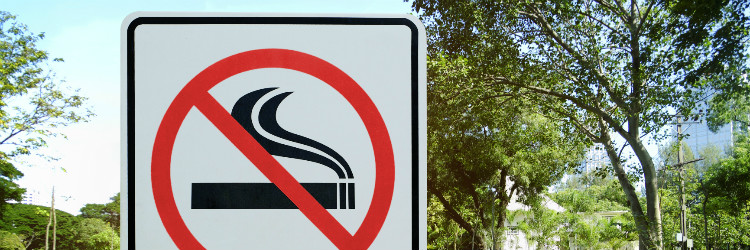Goal Area 2: Eliminating Nonsmokers’ Exposure to Secondhand Smoke
The TPCP and the CDC share the goal of reducing the health burdens of tobacco use by eliminating nonsmokers’ exposure to secondhand smoke.
Support for Smokefree Indoor Air Policies and Laws
The ATS gathered information regarding Wyoming adults’ opinions on smokefree indoor air policies and laws. Different ATS questions asked about support for policies, rules put in place by individual businesses, and statewide laws.
The ATS items about smokefree indoor air policies asked adults if they think smoking should be allowed indoors at workplaces, restaurants, bars, and casinos/clubs. (Casinos and clubs were combined on the survey, so were treated as a single venue type.)
The survey questions about smokefree laws asked respondents if they support or oppose statewide smokefree indoor air laws in Wyoming for the same venues.
Support for smokefree air policies continued to grow in 2019. That support is the highest for indoor workplaces; however, support has basically leveled out since 2015. Support is weakest for venues considered adult only (Figure 19). Between 2004 and 2012, the ATS included a single item about support for smokefree bars, casinos, and clubs. After 2012, that was split into two items: one for bars and one for casinos and clubs. Although these older estimates are not directly comparable to estimates from the related items on the 2015 and later surveys, Figure 19 includes them as a historical reference.

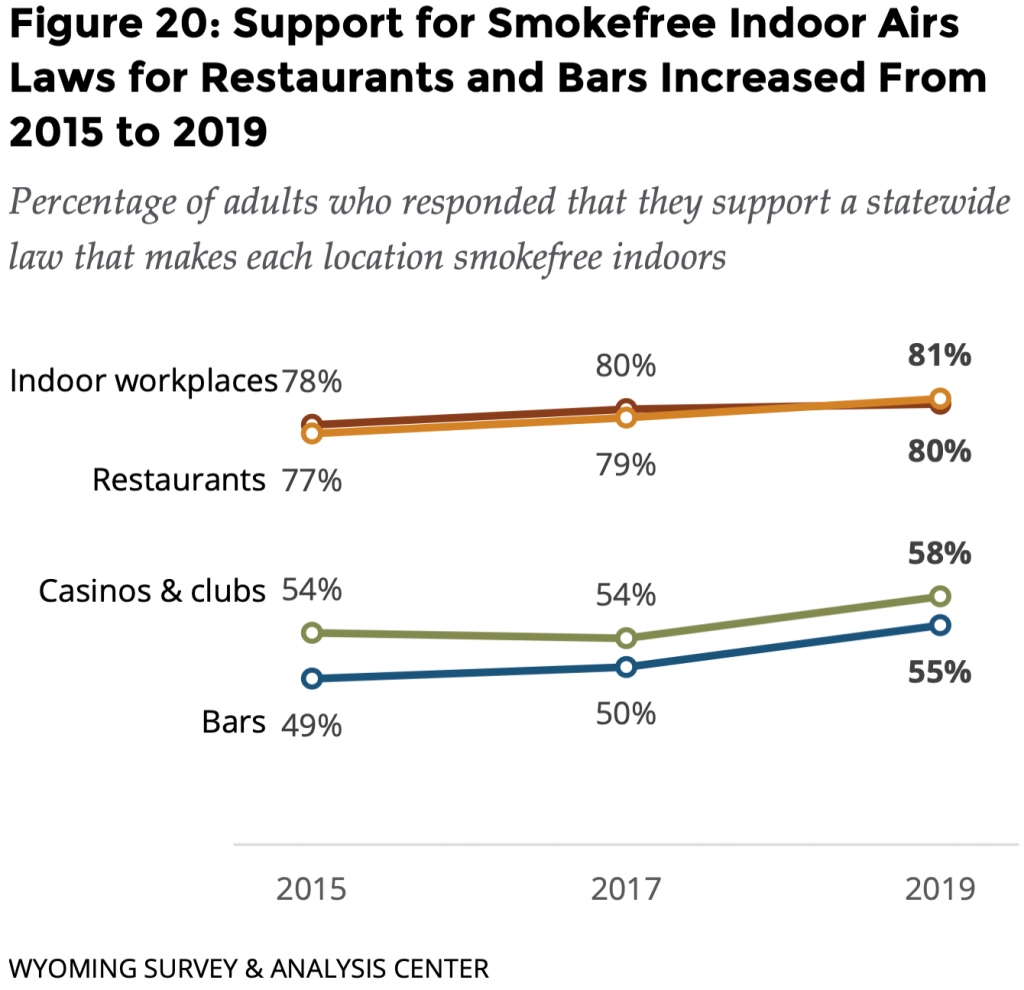
Support for smokefree indoor air laws has increased since 2015. The levels of support for smokefree indoor air laws are very similar to those for smokefree indoor policies (Figure 20).
Demographic Differences in Support for Statewide Indoor Smokefree Air Laws
Potential associations were examined between support for state smokefree indoor air laws and seven demographic variables: gender, education, annual household income, sexual orientation, age, race, and ethnicity. Each of the four venues in Figure 20 were looked at separately to see which demographic variables were associated with more or less support for statewide smokefree air laws.
Age, race (White or non-White), and ethnicity (Hispanic or non-Hispanic) were not significantly associated with support for legally protected smokefree indoor air for any of the four venues.
When accounting for the other demographic variables, gender was the only variable significantly associated with support for smokefree indoor air laws across all venues. For each venue, men were less likely to support smokefree indoor air laws than women.
Additional demographic variables were related to smokefree indoor air laws covering specific venues. These relationships are summarized in this section, with full results in Appendix C: Statistical Analysis Methods and Detailed Results.
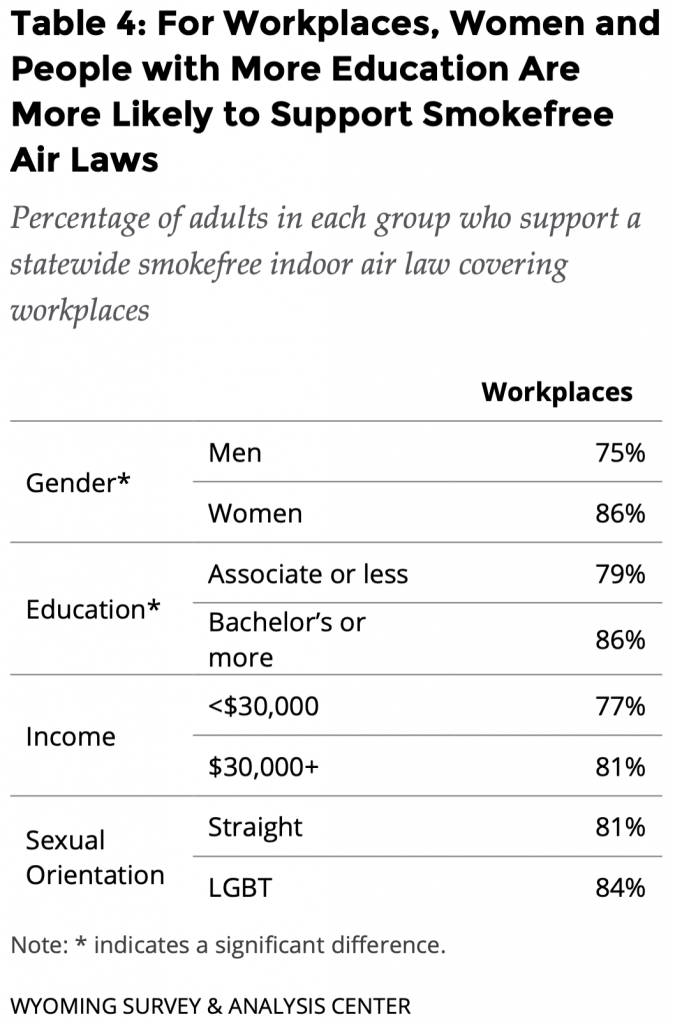
Most people (80%) support smokefree air laws for workplaces (Figure 20). Gender and education were significantly associated with support for smokefree air laws (Table 4). Women and those with at least a bachelor’s degree were more likely to support the laws. Income and sexual orientation did not have significant differences in support. Overall, support for smokefree workplaces is very high for all demographic groups.
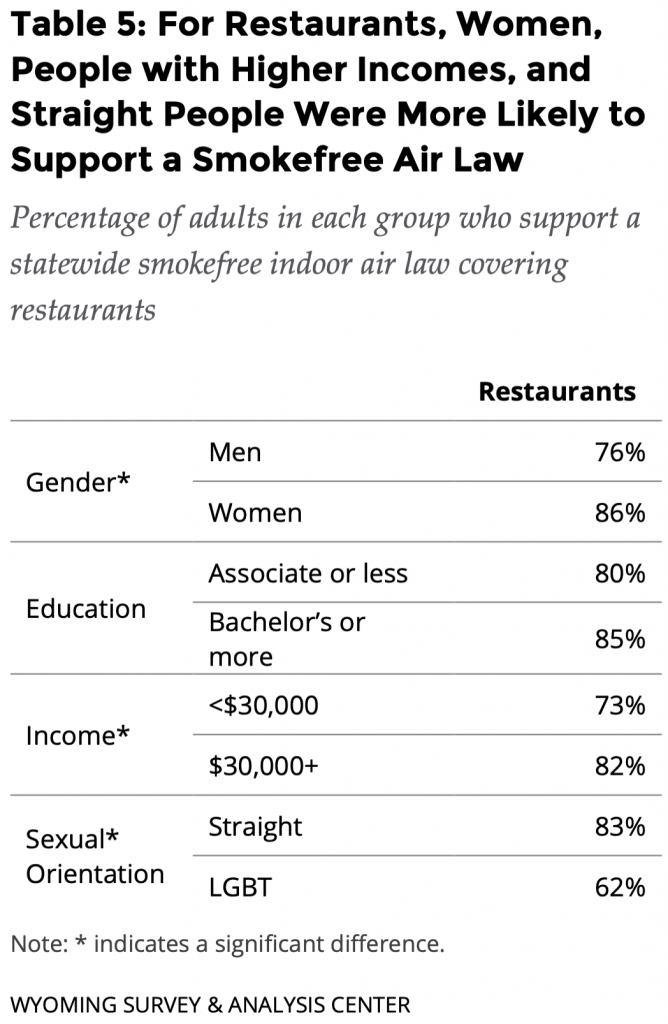 Most people (81%) support smokefree air laws for restaurants (Figure 20). However, there were significant differences in support for gender, income, and sexual orientation (Table 5). Women, those making over $30,000 per year, and those who identify as straight were more likely to support smokefree air laws in restaurants. Overall, support for smokefree air laws in restaurants is very high for all demographic groups.
Most people (81%) support smokefree air laws for restaurants (Figure 20). However, there were significant differences in support for gender, income, and sexual orientation (Table 5). Women, those making over $30,000 per year, and those who identify as straight were more likely to support smokefree air laws in restaurants. Overall, support for smokefree air laws in restaurants is very high for all demographic groups.
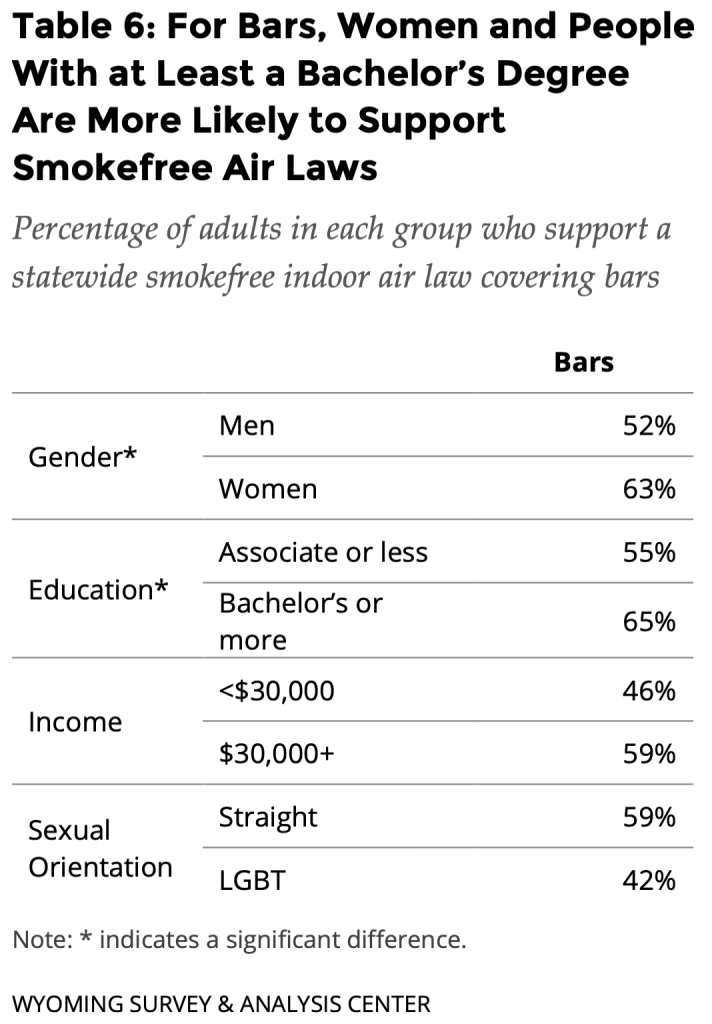 Overall, a slim majority (55%) of people support smokefree air laws in bars (Figure 20). As in workplaces, women and those with at least a bachelor’s degree were more likely to support legal protections (Table 6). For most demographic groups, a majority of adults support smokefree laws covering bars.
Overall, a slim majority (55%) of people support smokefree air laws in bars (Figure 20). As in workplaces, women and those with at least a bachelor’s degree were more likely to support legal protections (Table 6). For most demographic groups, a majority of adults support smokefree laws covering bars.
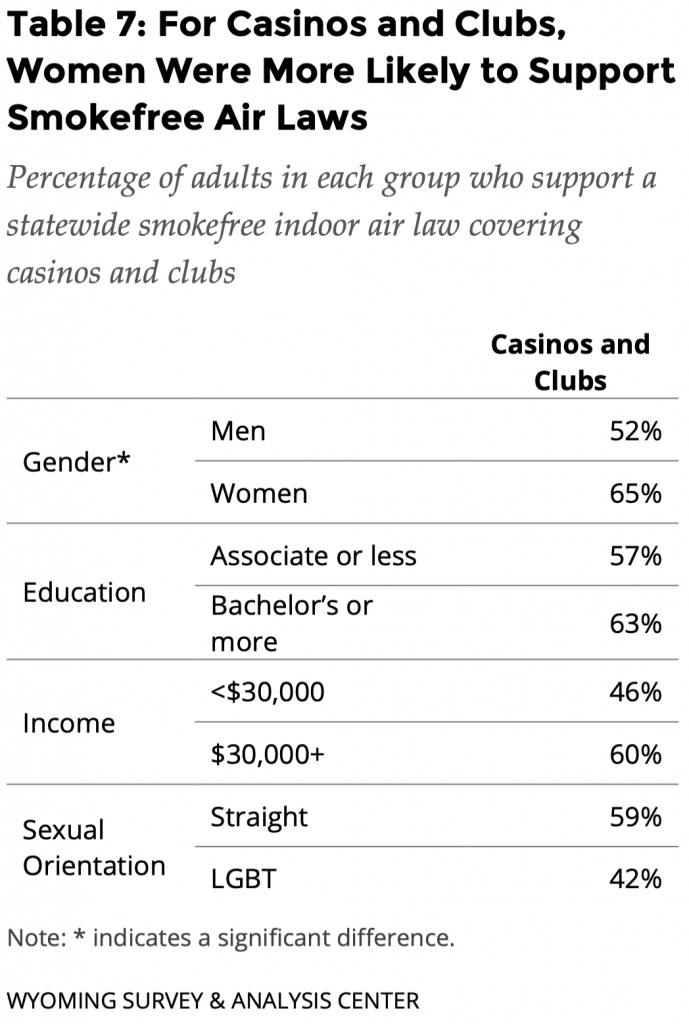 In casinos and clubs, like bars, a slim majority, 58%, of adults support legal protections for smokefree air (Figure 20). Gender was the only demographic variable that showed a significant difference, with women being more likely to support laws (Table 7). For most demographic groups, a majority of adults support smokefree laws covering casinos and clubs.
In casinos and clubs, like bars, a slim majority, 58%, of adults support legal protections for smokefree air (Figure 20). Gender was the only demographic variable that showed a significant difference, with women being more likely to support laws (Table 7). For most demographic groups, a majority of adults support smokefree laws covering casinos and clubs.
Adult venues (bars, casinos, and clubs) had much lower support for smokefree air laws from all demographics, but most adults support legal protection.
Support for Other Smokefree Air Policies and Laws
Outdoor Parks Policy
Most Wyomingites (83%) thought that smoking should be restricted at outdoor parks, at least in some manner. This proportion has significantly increased from 76% in 2010. Complete restrictions are less popular than partial restrictions. In 2019, 36% of adults thought that smoking should never be allowed, and 47% of adults thought that smoking should be allowed only at some times or in some places.
Outdoor Workplaces Law
Support for laws making outdoor workplaces smokefree was substantially lower than support for laws making indoor workplaces smokefree: Only 30% of adults support a statewide smokefree air law for all outdoor workplaces. The level of support for such a law in 2019 has not changed significantly since comparable questions were first asked in 2015.
Tobacco-Free School Policy
 Support for tobacco-free schools has been consistently high since 2010. In 2019, 85% of adults indicated that all school events should be tobacco-free for all students, staff, and visitors on all school grounds, fields, and parking lots (Figure 21). There was no significant difference between adults who had a child living with them and those who did not.
Support for tobacco-free schools has been consistently high since 2010. In 2019, 85% of adults indicated that all school events should be tobacco-free for all students, staff, and visitors on all school grounds, fields, and parking lots (Figure 21). There was no significant difference between adults who had a child living with them and those who did not.
Exposure to Secondhand Smoke
Smoking Prohibited Indoors/Outdoors at Work
 Most employed adults (87%) reported that smoking was never allowed in indoor areas (including inside a vehicle) at their place of work. The question asked in 2019 does not allow direct comparisons to earlier data, but does not show a dramatic change over time. However, relatively few adults (27%) reported that smoking was not allowed in outdoor areas, which has been consistent since 2012 after a drop from 36% in 2010, when comparable questions were first asked (Figure 22).
Most employed adults (87%) reported that smoking was never allowed in indoor areas (including inside a vehicle) at their place of work. The question asked in 2019 does not allow direct comparisons to earlier data, but does not show a dramatic change over time. However, relatively few adults (27%) reported that smoking was not allowed in outdoor areas, which has been consistent since 2012 after a drop from 36% in 2010, when comparable questions were first asked (Figure 22).
Exposure to Secondhand Smoke at Work or in Public
Consistently since 2010, most employed adults did not regularly experience secondhand smoke (SHS) exposure at their workplace, either indoors or outdoors. However, in 2019, about 1 in 5 (21%) working adults still reported that they had breathed someone else’s smoke at their workplace in the past seven days.
In public places, indoors and outdoors, 1 in 3 people reported breathing someone else’s smoke in the past seven days (Figure 23). Although still a cause for concern, this is significantly less than the 2012 rate (45%), when comparable questions were first asked. Further, the chances of being exposed to SHS while in a public place is not significantly different between current smokers and nonsmokers: 38% of current smokers reported exposure to SHS while 34% of nonsmokers reported exposure to SHS in 2019. This lack of a difference could indicate that nonsmokers are unable to choose to avoid SHS exposure or often choose not to.
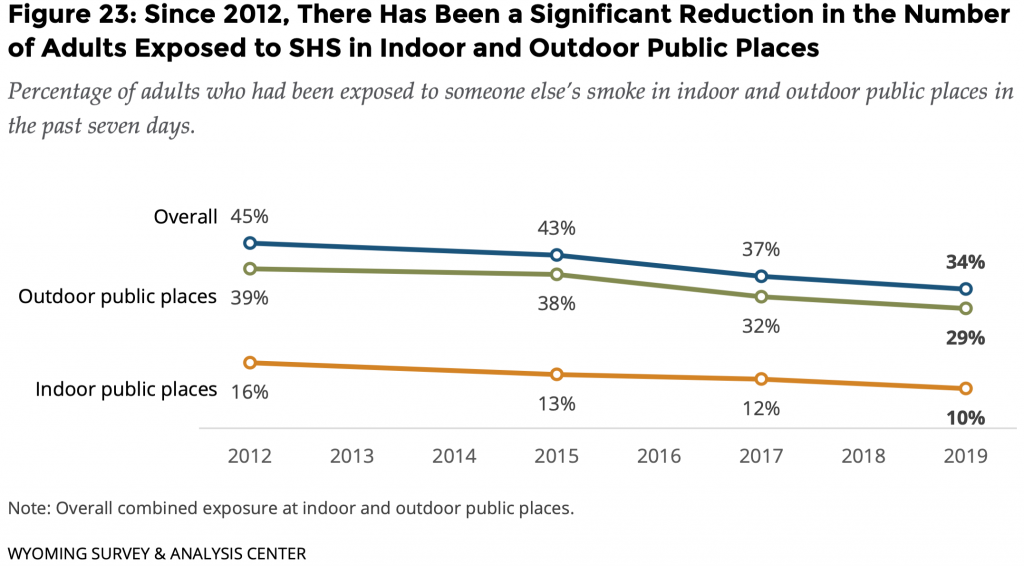
Opinions About Harmfulness of SHS
 Over the years, adults have almost unanimously agreed that SHS is harmful to one’s health (Figure 24). In 2019, the majority (63%) believed SHS is very harmful to one’s health, and 34% believed that SHS is somewhat harmful. Only 2% believed that it is not harmful. These levels of agreement have not changed significantly since a comparable question was first asked in 2010.
Over the years, adults have almost unanimously agreed that SHS is harmful to one’s health (Figure 24). In 2019, the majority (63%) believed SHS is very harmful to one’s health, and 34% believed that SHS is somewhat harmful. Only 2% believed that it is not harmful. These levels of agreement have not changed significantly since a comparable question was first asked in 2010.
Conclusions
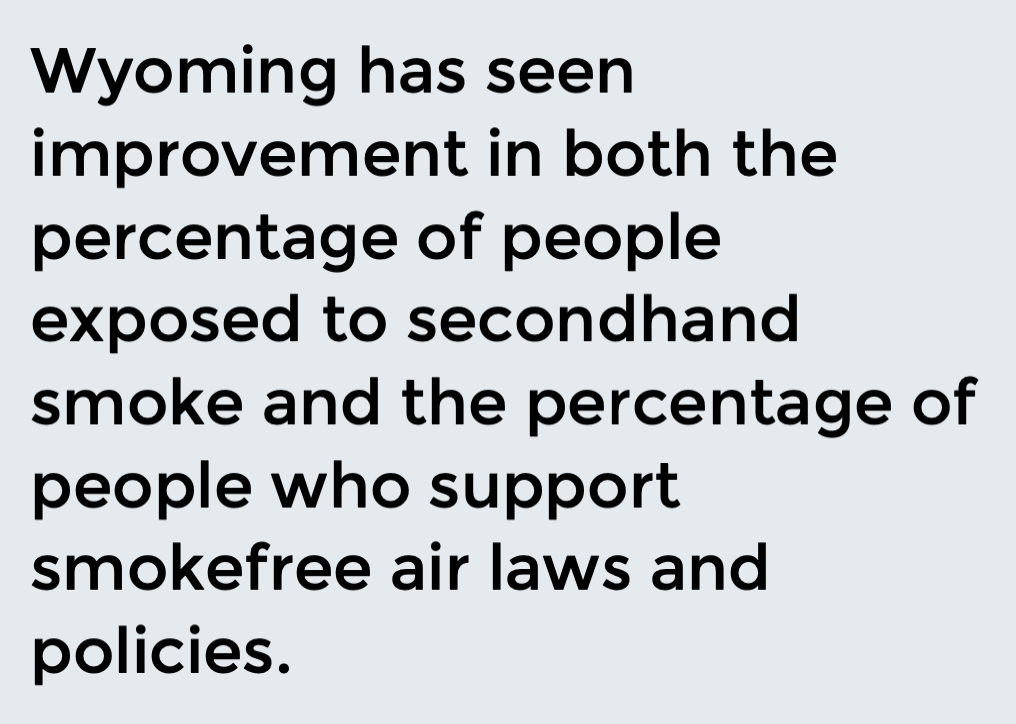 Wyoming has seen improvement in both the number of people exposed to secondhand smoke and the number of people who support smokefree air laws and policies. Adults exposed to SHS in public places decreased 24% since 2012. Between 2015 and 2019, support for smokefree indoor air laws increased significantly to 81% for restaurants and 55% for bars.
Wyoming has seen improvement in both the number of people exposed to secondhand smoke and the number of people who support smokefree air laws and policies. Adults exposed to SHS in public places decreased 24% since 2012. Between 2015 and 2019, support for smokefree indoor air laws increased significantly to 81% for restaurants and 55% for bars.
However, Wyoming still has room for improvement. In public places, 1 in 3 adults still report SHS exposure in the last week. A slight majority of adults think that smoking should not be allowed in bars, and men are generally less likely to support smokefree air laws and policies in all venues. Wyoming can still improve by increasing support for smokefree air in adult-oriented businesses and further protecting people at work and in public.
